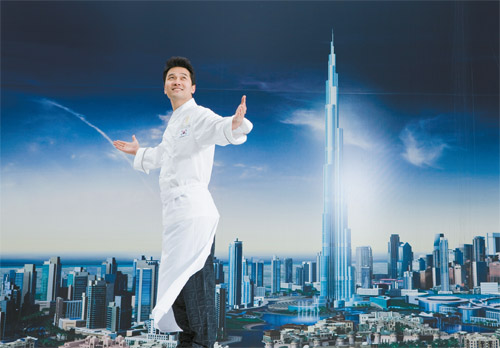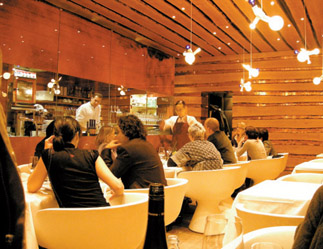Cold noodles in Vienna, bossam in Tokyo

Edward Kwon, a Korean chef at the posh Arabian hotel, Burj Al Arab, dreams of promoting his home cuisine to the world. The question is, though, whether it is possible for Korean food to make it truly big in the gastronomical pleasure market of the worldwide gourmets. The JoongAng Ilbo investigates with an in-depth series. By Kwon Hyeok-jae
Kim Kocht
It’s possible that just about everyone in Austria’s capital has heard of Kim Kocht, a Korean fusion restaurant near the State Opera House in Vienna. Founded in 2001 by owner and manager Kim So-hee, 42, it’s a popular dining place for locals.

The interior of Kim Kocht in Vienna. [JoongAng Ilbo]
There are two dinner choices: the three-course meal that costs 45 euros ($59.45) and is served at 6 p.m., and the five-course meal that costs 65 euros and is served at 8 p.m. Wine and other beverages aren’t included.
For lunch, you have more choices. There is a three-course meal for 39 euros and separate dishes, from appetizers through to desserts. Though prices for separate dishes range from 2.8 to 8 euros, which is quite high, there are hardly any empty tables at the restaurant.
Last month, Kim Kocht was packed with diners from all over Europe hoping to experiment with new Oriental tastes. In fact, Kim Kocht is a tempting spot for people living in German-speaking countries. Many diners probably already know Kim, the owner, from his TV appearances on cooking shows where she shares her recipes for organic dishes using vegetables and seafood. Her cookbooks have also become popular in bookstores and wine shops in Vienna.
The reason for the restaurant’s success is Kim’s philosophy: to serve the best quality food in any circumstances.
“It’s true that you need to consider the taste that suits the locals here, but what’s even more important is to serve food that satisfies my taste,” the owner said.
Meals served at Kim Kocht are traditionally Korean but they taste slightly different from the original. Kim says the difference in taste is natural.
“There is a limit to what Korean ingredients you can buy here, so as an alternative I use local produce,” Kim said.
Kim’s other philosophy in managing the restaurant is to provide the best quality service. “A restaurant shouldn’t only sell food but also service,” she said.
Kim pursues the kind of service that sprouts from the Korean culture of collectivism.
“When newlyweds stop by for a meal, I give them cold noodles mixed with vegetables and chili sauce from Busan for free,” she said. “Then I explain to them that noodles in Korea symbolize a long and happy life.”
Sosonjae in Tokyo
Sosonjae, a Korean restaurant in Samcheong-dong, central Seoul, has recently opened a branch in Azabu-Juban, a posh neighborhood in Minato, Tokyo.
Though the main branch is located in Seoul, the restaurant in Tokyo is managed by a Japanese food distribution company.
“People think of Korean bulgogi [marinated beef] restaurants as noisy and smoky. But Sosonjae in Tokyo tries to create a more elegant atmosphere. We target high-class Japanese,” said Sahoko Seki, the restaurant’s promotions manager.
Most of the furniture and decorations are from Japan and the restaurant’s chef is Japanese, but Seki says the taste of the food is truly Korean.
The chef serves food in kaiseki, a traditional Japanese multi-course dinner.
The Korean dishes are served in the same way as Japanese food. For example, the rice is served in a small ceramic bowl, just like in Japan, which makes it easier for diners to hold the rice bowl, which is their custom while they eat. And whereas Koreans prefer metal chopsticks, wooden ones are used.
The chef follows the recipe from the head branch in Samcheong-dong and uses ingredients brought directly from Seoul.
The main dish here is bossam, boiled pork wrapped in kimchi.
A dinner course that includes appetizers and watery plain kimchi, porridge, bossam, rice and soup costs 4,500 yen to 8,500 yen (70,000 won to 133,000 won).
Recently, the restaurant was selected as one of the 19 notable restaurants in Tokyo by food critics.
“Sosonjae makes food like a mother makes,” said Keiko Moriwaki, a local food critic.
“It is true that Korea’s representative food like kimchi, pan-fried food and soup have been distributed widely in Japan until now, but a variety of other Korean dishes should be introduced overseas to attract even more Korean food fans,” said Seki.
By Chae In-taek, Park So-young JoongAng Ilbo [angie@joongang.co.kr]










with the Korea JoongAng Daily
To write comments, please log in to one of the accounts.
Standards Board Policy (0/250자)